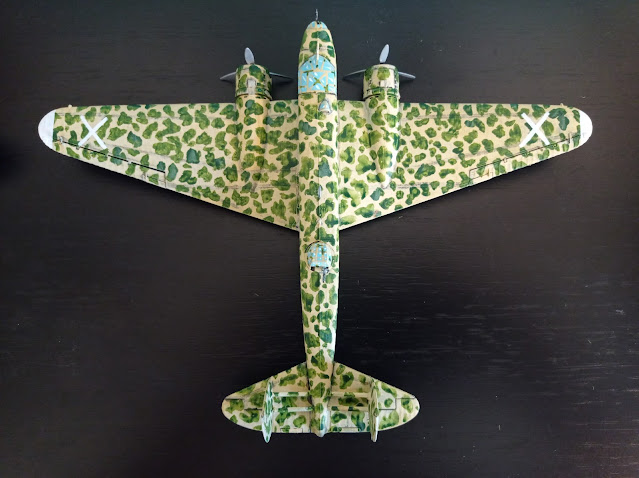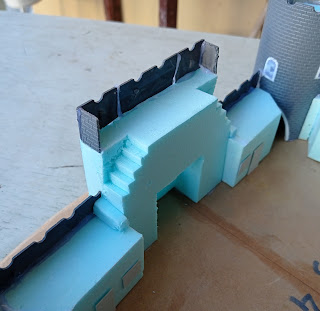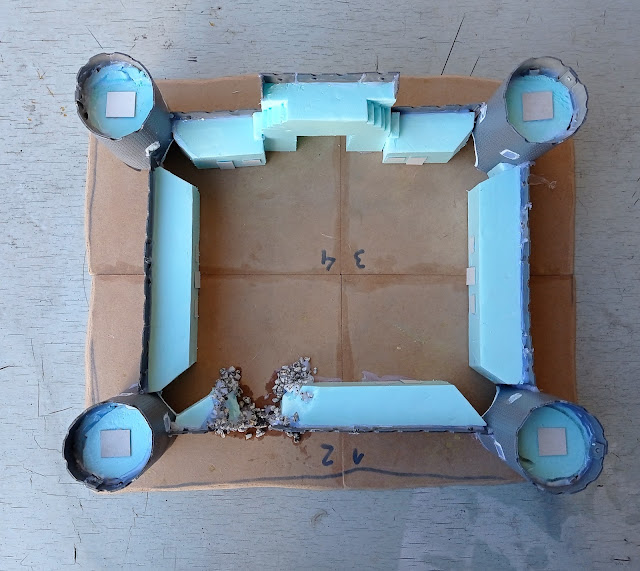Both mortars are scratchbuilt (the 3'' has a bipod from an airplane landing gear) with figures from all brands. The middle figure in the 2'' stand is the old Airfix holding a Bren. The ammunition magazine was carved out for the figure to look as if carrying an ordinary rifle.
This a wargaming place were you can see a growing collection of miniatures and terrain of many historical periods in 20mm (but also a few 10mm,15mm and 28mm) started when I was 10 yo. At the moment it has several tens of thousands of miniatures from foot figures to Destroyers. Occasionally there are some war movie critics and some travel to military sites. My family considers it the best wargaming site in the World even if it is the only one they know. More on @joaopeixoto5249 YouTube Channel.
Friday, 26 April 2024
Rapid Fire! Western Desert 1940-43 in 20mm - First New Zealand Battalion
Another battalion for the Western Desert and Crete parading this time in front of the captured Fort Capuzzo. And, again, an highly improbable one due this time to the lemon squeezer hats. Most probably the New Zealand infantry used always the Brodie helmet in action but modelling them with their cherished hat makes them distinguishable on the table and/or shelves.
For that I used plastic British from all sources with pinned heads from Airfix US WW1 infantry. Even if some are 1/72 and others are 1/76 they end up forming a realistic group . Well, not counting the hats, of course. StreletsR has a nice box of these guys if you prefer not to loose time converting them and piercing your fingers.
Here, (L to R) Matchbox, Esci and Airfix all living happily in the same stand. The Esci figure got a new head and also a new arm as the original is holding a pistol and something more administrative was necessary.
As an example this company is made of figures from the Matchbox, Esci and Airfix 8th army boxes and Esci WW2 box.
Next: Russian Tor systems to finish the BTGs AA groups.
Wednesday, 24 April 2024
The German 'Specials' at Market Garden for Rapid Fire! rules in 20mm
These German relatively rare vehicles and with different markings makes a funny addition to a late German force and were also a pleasure to collect. They came from a number of origins namely (better writing them due to my Portoenglish even if the video is an highly professional job with lots of hand movement):
- Char B1 Flamethrower - Matchbox conversions
- R35 w/ 47mm gun - ShellHole Scenics
- Fire Truck - Hasegawa conversion
- Dodge w/ trailer - Esci and Airfix
- Jeep - Airfix
- Panhard 178 - MiniGeneral
- Humber MkIV - Matchbox
- Renault AHN - S&S
- Umbaus - Converted 1/64 die-casts
- French 75/36 AA guns and IG37 - scratchbuilts
- Pz III F and M - Armorfast and PSC
- StuH 42 and Stug III C - Esci
- Colorful trucks - Alle-Hop (But you can have them from Aliexpress and such)
- Soviet 152mm guns - Irregular Miniatures
- Sdkfz 251/21 - Hasegawa conversions
- PzV Panthers - Esci and Matchbox
- PzVI KingTigers - Esci and Altaya
- Command car - 1/64 die-cast
Monday, 22 April 2024
The BR-20 bombers for Rapid Fire! Rules in 20mm size
Bombers from the 30s are one of my favorite themes in the history of WW2. I had these two Italeri Italian BR-20s for decades in the stash. Originally they were to be painted in Italian colors and fight in the desert or droping some bombs over England. But two other important users of the BR-20 were the Nationalist Spain and Japan. So, these two flew to these countries as I had no bomber for Franco and only one Betty for Japan.
The original kits are from the seventies but they withstood well the passage of time. These ones are from the 80s but look much more recent. My models had the German version on the cover and date from 1984.
Around 1937 the Japanese bomber force was in desperate need for a modern bomber for its operations in China as their KI-21 Sally were taking too long to be produced. Knowing of its usage in the SCW, Japan bought 82 BR-20 from Italy. Like this they can be used in the war against China or in the first few months after Pearl Harbor against the Allies.
The camouflage was the Italian one of the first 72 delivered (the second one of 10 was in the blotches camo you can see on the Spanish model).
The big Hinomaru are provided in the decals and make the model quite striking.
These should have been shown before the aircraft as they were made first. For a long time I wanted some bomber stands but all solutions didn´t seem right. So I glued two flutes using Araldite resin, as cyanoacrilate produces some vapor in the transparent plastic, and used two CDs as the ground base (heavily textured with small stones for balance) and the aircraft support base (painted sky blue). Like this the bombers are 35cm above the table in a relatively stable base and fighters can be on top of one flute only at about 17cm height.
The Spanish model was painted with green blotches using the same sand base as the Japanese version. 13 of them were delivered to Nationalist Spain.
From period pictures this camouflage looks to have been very effective. Recently I saw a YouTube video on the shooting down of Yamamoto and apparently one of the strenghts of the US airforce in this action was the green painting of their P-38s which, coming from below and over the jungle, were undetected until the last second.
All markings were hand painted.
The markings are for an aircraft of squadriglia 230 whose symbol was a stork catching a frog.
Next: a video on the German 'specials' for Market Garden.
Saturday, 20 April 2024
The Arnhem/Oosterbeek houses for Rapid Fire! rules in 20mm size
This is a group of the most famous houses of the Arnhem/Oosterbeek battles in September 1944 between the British 1st Airborne and the defending/counter-attacking Germans. Most of them are scratchbuilt in heavy duty card and wood for the bases. The biggest help came from the Then and Now two big volumes on the battle were you can see many of these buildings in period photos but also from the two great RF! supplements on Market Garden. Movies like A Bridge too far and Theirs is the Glory made the rest. In the Netherlands there is a RF wargamer called Ludwig that also made this and much more covering the entire area. If you look for him in RF related articles you can find plenty of his tasty pictures. Obviously if you don´t want to scratchbuild these structures you can go resin or nowadays 3d prints were all this material is also available.
Sunday, 7 April 2024
Rapid Fire! Western Desert 1940-43 in 20mm - Fort Capuzzo
Fort Capuzzo was an Italian large structure in the Lybian and Egyptian border built in the 20s to prevent the passage of the Sanussi tribesmen. In WW2 it changed hands several times as it was placed right in the middle of most of the more important offensives from both sides.This fort has been on my plans for some time. I never had the Airfix desert fort nor any nice resin fort and I wanted something with the proper gate of Fort Capuzzo. At the same time the building should be used in other periods of history (more on that later) as it should be something like 40cmX40cm. In fact it ended 40cmX33cm, large enough for a RF battalion to be placed inside.

While looking for Lego Bionicles for my 6 years old boy in a Chinese shop I found these 1 euro tower & walls from the Christmas period. I brought four of them and Capuzzo started to have a shape, at least on my mind.
With the help of the cheap 1 euro models and BlueBoard the construction was an easy affair. All windows were covered with hot glue gun and the whole structure was glued to plywood. Soon I realized that the turrets should have been much shorter but it was too late.
The way other periods of history are possible for this fort is by making the inscription "Ridotta Capuzzo - Amseat- "in a piece of clear plastic...
... and take it out whenever is necessary. The plastic piece just need to sit in some L shaped pin.

The most recognizable part of Capuzzo was its gate and some work was placed on it. Even so I skipped many details for this structure to be as generic as possible.
BlueFoam was used in most structures as its a resistant and easy to work material.
When building something like that you have the choice of building it in a pristine pre-war looks or with some sort of damage.
I went for the second and with the help of some plastic breaking, small pebbles and a hot glue gun something already destroyed was achieved.
The fort was in fact not a single structure but a big number of dwellings and separate buildings and walls.
I kept as simple as possible thinking also about placing some extra buildings inside and outside of the fort.
The true Fort Capuzzo from the sky. The towers were more detached from the walls than in my model and the number of buildings was simply too much to replicate. In the end, a couple of extra desert buildings inside and outside will do the trick.
Next: maybe some WW2 Mediterranean New Zealanders.

























